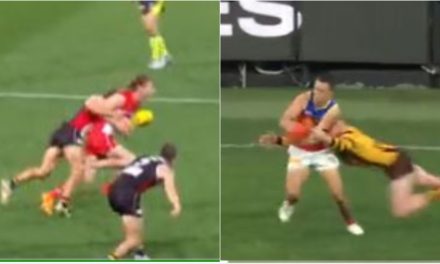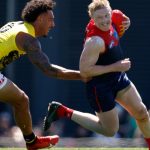Tiger Jason Castagna knew Hawk defender Jack Gunston had won their race. So did the goal umpire. Not so the video reviewers, who at first awarded a goal.
AFL score review system still hitting the post a decade later
The introduction of video technology into sports adjudication has been a vexed issue for quite a while now.
Few people would argue the toss about the philosophy behind it, making as sure as possible that the correct decisions are made. It’s the implementation and execution that causes all the headaches.
Well, for some sports. Tennis, for example, a pioneer in the field, seems to have no such issues with its Hawk-Eye, almost certainly because a ball hitting a line or not is a pretty simple black and white call, quickly requested and judged.
But there’s few, if any other sports, which haven’t had their problems with it. Cricket’s DRS, for example, is now not just a method of ruling on stumpings and run outs, but LBWs, catches, no-balls, even boundaries.
And decisions on its use for captains or batsmen are virtually strategies to go with bowling rotations, field placements and declarations.
Football codes, meanwhile, have presented on-going challenges. In rugby league, the video referee is now as much a part of each game as the full-back or front-rower. Domestically, the A-League’s trial of the VAR appears to have created more problems than it has solved. And nor is the AFL immune.
Score reviews in the AFL might still occupy a small percentage of decisions made during a game of near two hours’ duration. But they continue to cause more than their share of grief. And round three hardly provided a ringing endorsement for their upside.
At Etihad Stadium on Saturday night, Adelaide’s Richard Douglas appeared to have kicked a goal despite a desperate St Kilda smother, endorsed by a goal umpire who wanted to check whether there in fact had been a faint touch.
A long delay and countless replays for the men in the video box ensued, none seemingly any clearer than the last. Surely that meant the decision remained a goal? Nope. The video folks had obviously spotted something no one else had been able to see.
Coincidentally, at almost the same moment in the Sydney-GWS game at the SCG, a similar incident took place. This time, the process was quick, clean and efficient, and given the inconclusiveness of the vision, the on-field official’s original call enshrined.
But that was a rare tick on a bad weekend for the score review. Because on Sunday in Melbourne and Perth came two complete howlers.
At the MCG in the Richmond-Hawthorn game, Tiger forward Jason Castagna and Hawk defender Jack Gunston jostled to get to a ball heading across the Richmond goal line first.
Gunston clearly got there, Castagna not. But the score review incredibly confirmed a Richmond goal. That was until the vociferous protests of an army of Hawks caused the field umpire to call for a review of the review.
Eventually, justice prevailed, seemingly the only explanation that the video team, having watched regular forward Gunston in action, had momentarily got their ends mixed up and thought he’d kicked a goal for his own side.
Then, in the final game of the round at Optus Stadium, West Coast’s Chris Masten marked in the goal square and played on, Geelong defender Tom Stewart desperately trying to get a hand to the ball as he kicked.
The goal umpire called a goal, but wanted to double check. The only relevant replay showed clearly that Stewart’s hand and arm came over the top of Masten’s foot, but that the Eagle had got a clear boot to ball. Incredibly, the goal umpire’s call was overturned.
You could write all this off as a bad couple of days, but for the fact the anomalies and inconsistencies just keep cropping up. Clearly enough to concern the AFL, which to its credit had football operations boss Steve Hocking straight on the front foot on Monday to underline that the reviews were intended to support rather than intervene on the umpire’s behalf, and were there for the obvious errors, not to rake over every incident with a fine-tooth comb.
But the fact the slip-ups continue a good decade after Geelong’s Tom Hawkins goal in the nail-biting 2009 grand final (which had actually shaved a post) began the discussion about introducing score reviews would seem to indicate this isn’t just about the odd error here and there, but a fundamental flaw in the system.
It was two-and-a-half years after the Hawkins goal, for the 2012 season, that the AFL finally took the plunge. But despite that lead-up time, the system had plenty of holes. That might have been understandable. That those problems continue to occur six years later isn’t.
We still don’t have the same access to the same amount of replays at every venue, the extent of coverage dependent on the broadcaster. We still don’t have consistency in either when reviews are called, or in how they’re ruled upon by the officials upstairs.
And like other sports, we routinely exceed the original brief, shots which may or may not have been touched off the mark 30-40 metres from goal also regularly reviewed despite the near-impossibility of an accurate call.
In the first weekend of the season, the score review was used effectively to judge whether a Port Adelaide player had taken a mark or not on the line between the goal and point post. The decision was a legitimate mark, but in the meantime, he’d lost his opportunity to play on and reduce the angle to goal.
As for the necessity for the video evidence to be conclusive to overturn an original decision, wasn’t the number of replays waded through to arrive at a decision on Douglas’s goal on Saturday night enough of a statement in itself that the evidence was in no way conclusive?
The AFL football operations department has plenty on its plate. But the whole video review system needs to be a much higher priority than it has been. That Hawkins goal nearly 10 years ago was as close as we’ve come to the line about “what if it costs a team a premiership” actually occurring. Surely that’s been more than enough time not just to institute the checks and balances to make sure there’s not a repeat, but to make sure they actually work properly?












In the Rich v Haw game the goal umpire must have also confused which end he was at otherwise there was no reason to even send it for review. The only possibilities were that the ball came off Gunstun from his shin or foot, or off Castagna’s body. There was never a possibility of a goal yet the umpire called for a review! So clearly the goal umpire was confused and maybe that was what led the video ump to get confused, i.e. “if this has been sent to me for review my muppet colleague must be asking if it came off the Hawthorn boot and therefore a goal”
It is not that hard. It is umpires call unless they can spot something obvious in the first 20 seconds.